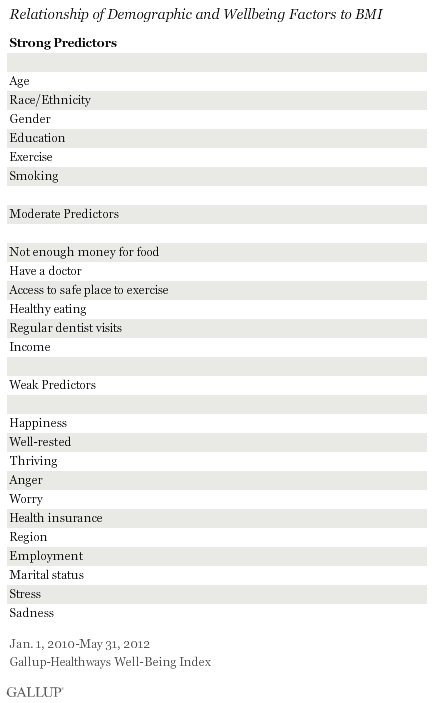PRINCETON, NJ -- Being middle-aged or black is more closely linked to being overweight -- defined as having a high Body Mass Index -- than any of 25 other factors, including exercise and healthy eating, examined in a Gallup analysis of the correlates of weight in America today. The analysis of interviews with more than 850,000 Americans also finds that being a man, having a lower level of education, not smoking, and not exercising are also strongly related to being overweight. Conversely, being very young or very old, Asian, a woman, having a high education level, smoking, and exercising three or more days per week are linked to having a low BMI.
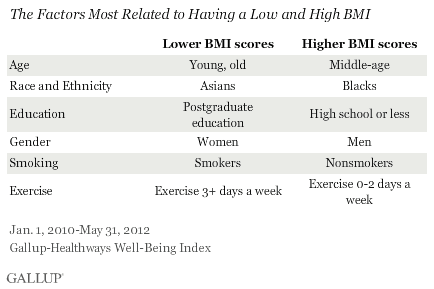
The findings are based on data collected as part of the Gallup-Healthways Well-Being Index from Jan. 1, 2010 through May 31, 2012. Gallup calculates respondents' BMI using the standard formula based on their self-reported height and weight. In these data, the average BMI for U.S. adults was 27.0. The analysis estimated the relationship between BMI and each of 25 demographic and well-being factors while controlling for age, ethnicity, race, marital status, gender, employment, income, education, and region.
Average BMI Increases as Americans Enter Middle Age
Americans' BMIs are lowest when they are quite young -- an average of 24.9 among those aged 18 to 24 -- but begin to rise as Americans age, peaking in the 55 to 59 age group at an average of 28.5. BMI begins to fall thereafter, particularly when Americans reach the age of 80. The average BMI for Americans 90 years of age and older is the lowest of any age group, at 23.8.
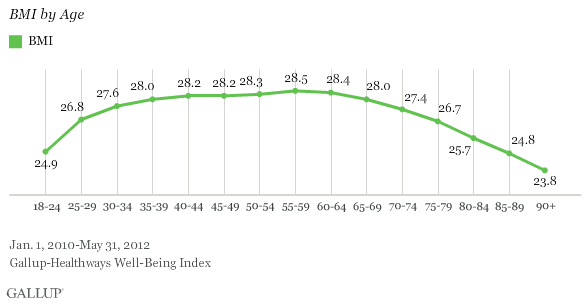
Blacks and Asians at High and Low End of BMI Spectrum
The majority of Americans are non-Hispanic whites, so it is to be expected to find that whites' average BMI (26.8) is close to the national average. Hispanics' average BMI is also close to the national average. On the other hand, the two racial groups that stand out are blacks and Asians.
Blacks have the highest average BMI score (28.2) of any major race or ethnic group, while Asians have the lowest -- 25.1. Given that these estimates are based on an analysis that controls for a list of demographic factors that are correlated with race and with weight, the results suggest that something about either the genetics or social and cultural environments of these racial groups may be responsible for their relative weight status.

Lack of Education Linked to a Higher BMI
There is a modest inverse relationship between educational attainment and weight, with Americans with a high school education or less having the highest BMI average -- 27.6 -- while those who have a postgraduate education have the lowest BMI average -- 26.3. This could suggest that awareness of the health benefits of good eating and weight control increases with education.
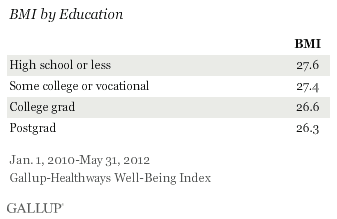
Those Who Smoke Have a Lower BMI Than Those Who Don't
It is generally agreed that smoking and being overweight lead to lower probabilities of a healthy life and a long lifespan. Yet the data show that smoking and BMI are in and of themselves are inversely related. Americans who smoke have a significantly lower average BMIs than those who do not smoke. Since this analysis controls for demographic correlates of smoking and higher weight, the data suggest that smoking may either dull the appetite or satisfy oral cravings that otherwise might be satisfied with increased consumption of food.
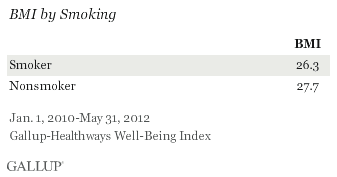
Despite this relationship between smoking and lower BMIs, the numerous health risks associated with the practice make it an extremely poor candidate in terms of advice for long-term weight loss.
Exercise Is a Key to Lower BMI
Unlike the situation with smoking, the finding that those who exercise three or more days a week have lower average BMIs supports a method of weight maintenance that health authorities heartily endorse. It is generally agreed that exercise is itself correlated with better long-term health, and these data show that regular exercise is also associated with a lower probability of being overweight. Thus regular exercise helps in attaining two important well-being goals.
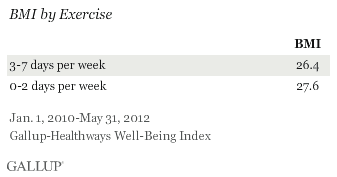
Emotional Factors, Having Health Insurance Not Highly Related to BMI
The analysis finds that other measures of well-being, including high life ratings; being well-rested; and emotions including worry, sadness, stress, anger, and happiness, were not strongly related to BMI once demographic factors were taken into account. Similarly, having health insurance and having easy access to clean water, fruits and vegetables, and a safe place to exercise made little substantive difference.
One additional variable moderately related to a higher BMI is worth noting: not having enough money to buy food. This relationship suggests that those in this category -- even controlling for income and other demographic variables -- may be in a position where they eat cheaper, less healthy food.
Bottom Line
The epidemic of obesity in the U.S. has high costs for both the individuals themselves and for society. Obesity is related to higher levels of chronic conditions such as high blood pressure and diabetes, as well as a lower quality of life -- including worse emotional health, more daily pain, and more missed work. It is also tied to shorter life expectancy.
This new analysis makes it clear that being overweight is not distributed randomly throughout the population. Body Mass Index is higher among those in their middle-age years, men, blacks, those with lower levels of education, and those who don't exercise. Clearly efforts to attack the weight problem in America need to focus on these groups.
But, a focus on the positive side of the equation -- looking at the factors most related to low BMIs -- might reveal key insights that could be applied throughout society. This would involve analyzing what it is about being very young or very old, a woman, highly-educated, Asian, and a frequent exerciser that keeps BMI low.
Gallup will publish additional findings further exploring the "whys" of the fact that certain groups, taken as a whole, tend to have lower BMIs, while others tend to land on the higher end of the scale.
About the Gallup-Healthways Well-Being Index
The Gallup-Healthways Well-Being Index tracks well-being in the U.S., U.K., and Germany and provides best-in-class solutions for a healthier world. To learn more, please visit well-beingindex.com.
Survey Methods
Results are based on telephone interviews conducted as part of the Gallup-Healthways Well-Being Index survey Jan. 1, 2010-May 31, 2012, with a random sample of 808,660 adults, aged 18 or older, living in all 50 U.S. states and the District of Columbia.
For results based on the total sample of national adults, one can say with 95% confidence that the maximum margin of sampling error is ±1 percentage point.
Interviews are conducted with respondents on landline telephones and cellular phones, with interviews conducted in Spanish for respondents who are primarily Spanish-speaking. Each sample includes a minimum quota of 400 cell phone respondents and 600 landline respondents per 1,000 national adults, with additional minimum quotas among landline respondents by region. Landline telephone numbers are chosen at random among listed telephone numbers. Cell phones numbers are selected using random digit dial methods. Landline respondents are chosen at random within each household on the basis of which member had the most recent birthday.
Samples are weighted by gender, age, race, Hispanic ethnicity, education, region, adults in the household, and phone status (cell phone-only/landline only/both, cell phone mostly, and having an unlisted landline number). Demographic weighting targets are based on the March 2011 Current Population Survey figures for the aged 18 and older non-institutionalized population living in U.S. telephone households. All reported margins of sampling error include the computed design effects for weighting and sample design.
In addition to sampling error, question wording and practical difficulties in conducting surveys can introduce error or bias into the findings of public opinion polls.
For more details on Gallup's polling methodology, visit https://www.gallup.com/.
